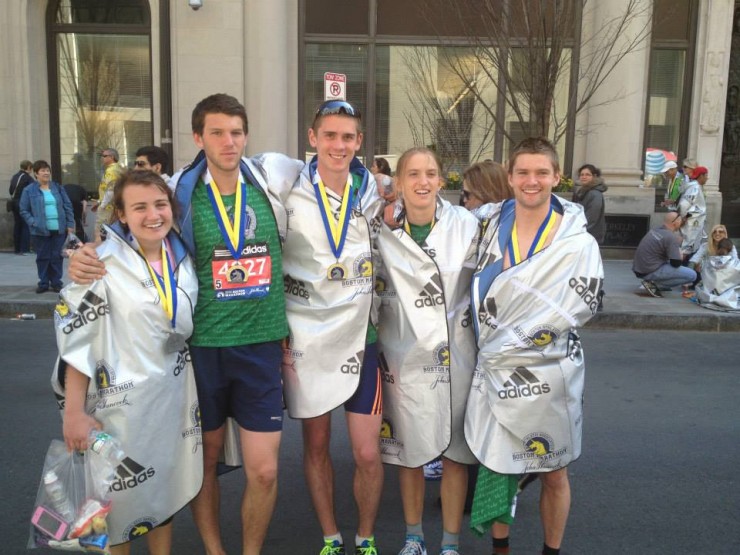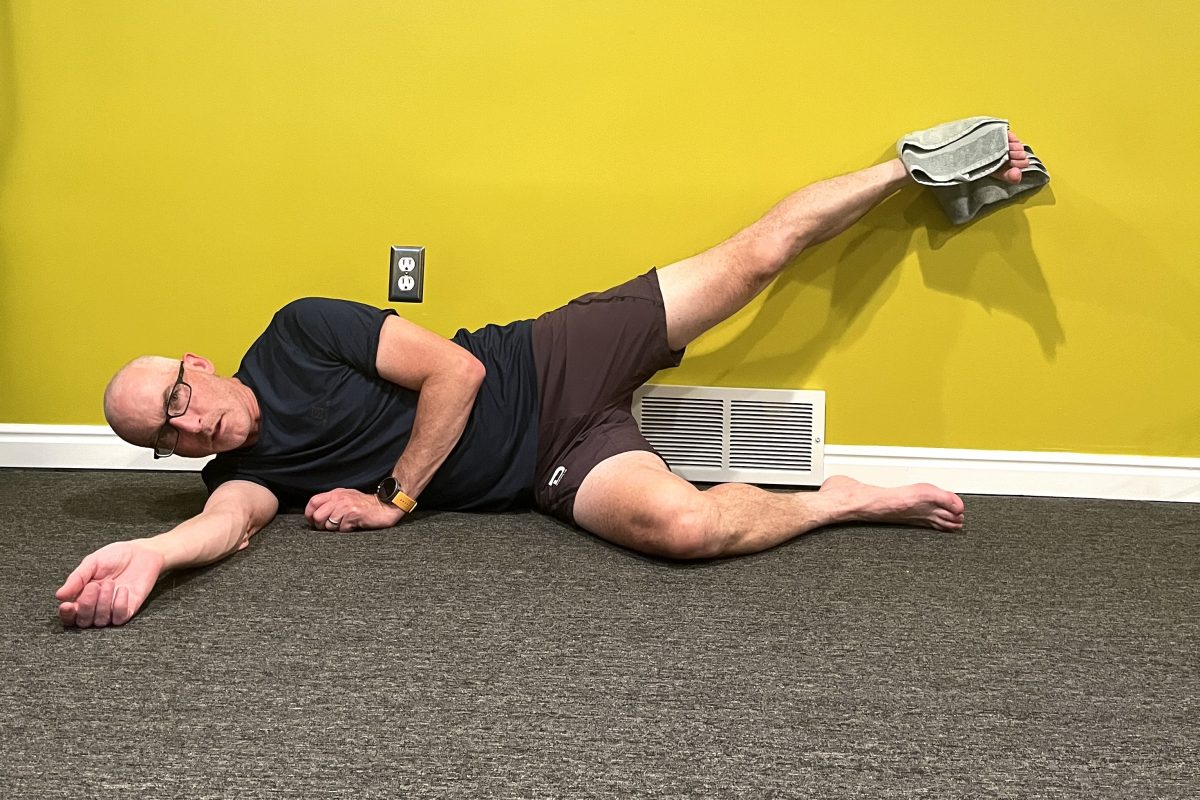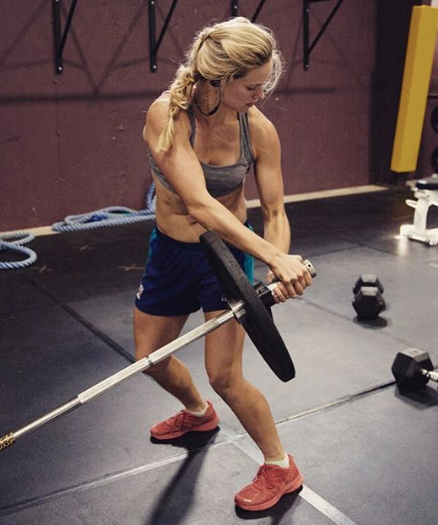
Two days after nearly 36,000 people ran that Boston Marathon on Monday, we’re willing to bet there are more than a couple still feeling the pain of the 26.2-mile run from Hopkinton, Mass., to Boston.
Isabel Caldwell, a former Dartmouth and Stratton skier and the younger sis of U.S. Ski Team member Sophie Caldwell, was one of them, but she didn’t feel as sore as she expected.
“My marathon went pretty well … I hadn’t done a whole lot of running before so I wasn’t expecting too much but I finished and had fun so it was a good day,” she wrote in an email. “The race experience was pretty amazing. There were so many people. I think I ended up finishing about halfway through the second wave of runners so I was surrounded by other runners the entire time. The sides of the course were also covered in spectators. It seemed like everyone was doing it for a greater cause this year, there were Boston Strong posters everywhere and all of the spectators and runners seemed very determined to make it the best Boston ever.”
We asked her what you do in the day (or two or three) after to relieve soreness in the legs and stiffness in other parts of the body. She wasn’t as sore as she was when she ran the Burlington Marathon in Vermont last year.
“I think difference is that last year at Burlington it was about 40 degrees and raining so as soon as I finished I got cold and my muscles seized up and I didn’t want to walk anywhere,” she explained. “For about a week afterwards I had horribly sore legs.”
Monday was warmer — upwards of 60 degrees by the finish — and Caldwell wrote that she had to walk a couple of miles to the subway, “which felt horrible at the time but was probably good for my recovery.”
Tuesday, she tried to stay off her feet.
“I have a lot of blisters, but I may try to roll out a little bit,” she wrote. “I probably won’t train for a few days and maybe just do a couple of bike rides later in the week.”
Her sister, Sophie, cheered her on near the finish. Definitely inspired to run a marathon someday, she wrote in an email that she’ll probably wait until after she’s done skiing professionally to avoid injury.
But the 2014 Olympian does know a lot about taking care of yourself after any race — especially endurance events.
No. 1: Fuel Properly
“Even though you might not have much of an appetite, eating and drinking enough would be really important,” Sophie wrote. “It’s probably also important to move a little so you don’t get too stiff and tight and then maybe an ice bath if you dare (I don’t).
No. 2: Accept and Minimize the Burn
“I think getting sore is inevitable, but there are definitely ways to make it less miserable! I was giving Isabel piggy back rides today, so I’m not sure she did the greatest job with recovery! In her defense, she had to sit in the car for four hours to drive back to Hanover.”





8 comments
adam st.pierre
April 23, 2014 at 10:59 am
I hate when mis-information is perpetuated so I’d like to clear a few things up:
Lactate does not cause sore legs.
Lactate does not cause fatigue.
Lactic Acid does not exist in the body.
Lactate is a byproduct of anaerobic metabolism. The end product of glycolysis is pyruvate, which then enters the TCA (or Kreb’s) cycle to produce energy aerobically. When energy is needed faster than it can be produced aerobically, pyruvate can be converted to lactate by the enzyme lactate dehydrogenase. In doing so, a few more ATP are created, and the chemical gradient allowing glycolysis to proceed is maintained. Once produced by the working muscles, lactate can enter the blood stream, where it can be taken up by neighboring muscles, or travel to muscles, tissues, and organs throughout the body. The heart and brain can remove lactate from the blood, convert it back to pyruvate, and utilize it for energy. Other muscle cells can do this as well. Resting blood lactate levels are usually between .7 and 2.1 mmol/L. The lactate level in the body is never 0. You are constantly utilizing a mixture of aerobic and anaerobic metabolism, even at rest. During exercise of low intensity (base, level 1,…) lactate levels should be between 1 and 1.5mmol/L (some people will say 2mmol/L is a more appropriate level for easy training, this is somewhat dependent on the athlete and the type of training undertaken by them. A marathon is typically run between 2.5 and 3mmol/L. The muscle soreness following a marathon is from actual damage to the muscle fibers, micro-trauma, small tears in the muscle itself. These tears expose molecules typically only found inside the cell to the blood, where immune cells react to it, causing inflammation. An ice bath immediately post muscle damaging workout will stop metabolic processes resulting in a lower net damage. This can be a good thing in some cases, but too frequent ice baths will actually blunt the positive adaptation to training. Mega doses of anti-oxidants can also decrease muscle soreness/damage, but they also blunt the positive adaptations. Walking and other forms of light exercise are recommended after a marathon because they increase blood flow to the damaged areas. This clears out the remnants of the damaged cells and brings more nutrients to the area to assist in the rebuilding process. During a high intensity workout, racing a 5-10km for instance. The body may produce 6-10 (or more) mmol/L of lactate. with 30 minutes of seated rest, lactate levels should return to near baseline. With 5-10 minutes of cool-down activity, lactate levels should return to near baseline. Lactate levels do not remain elevated in the body for very long post-workout, definitely not for 24-48 hours when muscle soreness peaks after a marathon.
Sorry for the rant, congrats to all the skiers (and the rest of the runners) who ran Boston, looked like a great day!
teamepokeedsbyn
April 23, 2014 at 7:44 pm
Dude,
pretty sure they are talking about the shit that makes your legs/arms burn like a bastard, and sore as a son of a bitch for days after a long one – call it what you want. Man, you must be the life of the cocktail party with your MS/PhD awesomeness.
rbladel
April 23, 2014 at 7:55 pm
Dear Mr. St. Pierre:
Nice summary of the physiology!
However, I was shown about 18 years ago in a training camp that lactate hangs around for at least a bit longer than a few minutes. Let me explain.
At a training camp run by Mr. Hall, and staffed by Darren Darrochie and a physiologist whom I only recall as Jerg, (forgive me all, for the likely misspellings.) we performed the following: We took baseline fingerstick lactates, warmed up, and did a 10 K time trial, four laps of a 2.5 K course, attempting to negative split each lap. (I came the closest ever to tossing my cookies at the end.) Lactates were taken again at the finish, which were of course high, and we then skied slowly back to our lodging, about a K or two, where we ate and rested.
About an hour or two later, we then dressed to ski, and had another lactate level taken. These were lower than at the end of the time trial, but not as low as our morning baseline. We were then instructed to ski at what we would now call level 1 for about 40 minutes, after which we had a final lactate level drawn. In all cases, our final lactate levels were significantly less than the post-prandial, post-rest, pre-slow 40 minute ski, and approached or equaled the day’s initial baseline level. The interpretation was that the residual somewhat-still-elevated lactate was used as the great fuel it is in presence of abundant oxygen during our slow recovery ski.
Of interest, the physiologist really only believed in three levels of exercise: below threshold, threshold, and above threshold. He thought that systems of training utilizing more levels than these were only for those attempting to make a name for themselves in the academic publishing word. I don’t know the literature to comment myself.
As this was about 18 years ago, I don’t recall any of the numbers, but the lesson made sense. I also don’t recall how sore I was in the following hours and days, but I agree that it’s probably not lactate that accounts for any soreness. I’m only a medical doc, not an exercise physiologist. Any comments from the real experts?
Tim Kelley
April 23, 2014 at 10:48 pm
teamepokeedsbyn: LMAO! Great post. Thanks.
magerl
April 24, 2014 at 11:56 am
Adam:
Thanks for taking the time to post. No doubt many skiers are very interested in detailed sports physiology information. I am most interested in your comments concerning ice baths. Can you cite some sources for this, especially the second portion that frequent ice baths can blunt the positive adaptation?
This question is not meant to challenge. Just eager to learn. I have read about ice bath studies on the AIS site as well as several NIH-published studies and am interested in reading more.
Thanks.
faceshots
April 26, 2014 at 7:21 am
Awesome to have a convo on these things… While it sucks having to go all nerd about this stuff, we kinda need to be scientific. I’m sure we’d all prefer light reading on “the shit that makes our legs sore”, but that’s not how this stuff works. If we were talking Race Cars we wouldn’t make a calibration and say “that shit makes it go faster better.”
adam st.pierre
April 29, 2014 at 5:59 pm
teamepokeedsbyn- I’m actually a pretty fun guy at a party with my MS awesomeness. Buy me a beer sometime and find out.
rbladel- I’d be interested to hear more about your camps (maybe Marty can chime in too!). I’ve had people do a morning test, ending with a few minutes at 6-9+mmol/L, take an hour break, then do another test. I’ve typically seen baselines prior to the second test lower than before the first test indicating that the lactate was cleared from the system very rapidly. Perhaps with a higher lactate level this recovery would be slower, or maybe people’s physiological make-up differs so some people clear faster than others. Email me at: stpierre.adam.d@gmail.com if you want to discuss further!
magerl- As far as I know the definitive study hasn’t been done (would be very difficult to do logistically), but here’s a summary of an interesting one by Alex Hutchinson:
http://www.runnersworld.com/injury-prevention-recovery/do-ice-baths-help-or-hurt-your-training
If you can get the actual study, it’s pretty interesting to read. Not perfect, but definitely makes you consider the goals for the workout and the goals for the training to follow the workout when deciding whether or not to take an ice bath. If you need to perform well 48 hours after a long/hard workout, then an ice bath may be beneficial, but if an ice bath blunts a small percentage of the training adaptation, then why not just cut the workout by a small percentage, run for 1:58 instead of 2 hours? I look forward to seeing more research in this area.
rbladel
May 1, 2014 at 12:11 pm
Mr. St. Pierre:
I will have to see if I can find old data from our time-trial/rest and recovery workout/lactate levels. Unfortunately, that was about 18 years ago, and I may no long have it. Perhaps Marty Hall can weigh in.
Thanks for the info regarding ice baths. Whether or not they actually work, I wish I had waded into cold Lake Michigan last evening after my first long dune pole run in many weeks. I’ve got a bad case of delayed-onset muscle soreness right now, which may be worse tomorrow.
Perhaps in a case like my present DOMS after an obvious overload training session, blunting the inflammatory response a bit with an ice bath will not actually decrease the training adaptation, because the body (at least my old one) can adapt only so fast anyway. I find that as I have gotten older, my recovery time seems to have increased as well. I may well get the same or better strength increases by going to the weight room every third day rather than every other, for example.